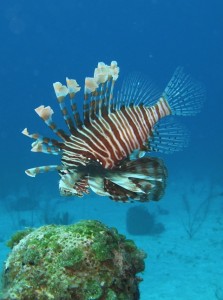
The lionfish, an invasive predator from the Indo Pacific currently wreaking havoc on Caribbean and South American coral reef fish populations, was first introduced to the region through the exotic aquarium trade. These beautiful carnivorous fish have characteristic orange and red stripes, spotted and striped pelvic and caudal fins, and flamboyantly colored wide-spreading pectoral fins, which they use to corral prey. These fins, though possibly to blame as the instigators of the devastating invasion, are now offering a new way to help control the rampant spread of the predatory fish.
Last week, in collaboration with CEI, the Eleuthera Arts and Cultural Center hosted a Lionfish Jewelry Making and Awareness Workshop, the first of its kind in The Bahamas. Local artists Shorlette Francis and Sterline Morley joined the Arts and Cultural Center’s Audrey Carey and CEI’s Dr. Jocelyn Curtis-Quick of the Lionfish Research and Education Program to put on the event. The collected attendees, a mix of professional artists, handicraft enthusiasts, and interested community members, learned about the arrival of the fish in the Caribbean in the mid-1980’s and its subsequent spread. After sampling fried lionfish and perusing lionfish crafts and jewelry by local artists for inspiration and construction techniques, the group tried their hand at creating wearable pieces from the fish’s unique fins.

Participants rolled up their sleeves and got creative, making beautiful necklace and earring pieces. Fins were varnished in their natural state or painted for more varied coloration; they could be trimmed, layered, or beaded. Enthusiasm about the finished products and the versatility of lionfish fins as a material led to many questions about where to get more of them, and will hopefully work to increase local demand for the fishing of these problematic fish. Be on the lookout for more jewelry workshops around Eleuthera, and for beautiful lionfish pieces to purchase. Do your part against the invasion by eating and wearing lionfish!